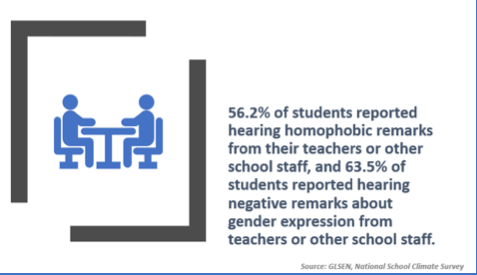Kelly Gleischman
November 1, 2018
As we close out LGBT History Month, it seemed like a great time to reflect on how critical talent work is for our LGBT students, particularly those who are bullied or silenced based on their identity. For me, this is deeply personal because I was one.
I was lucky. As a white girl growing up in a wealthy, relatively open environment, I experienced immense amounts of privilege. I still do, based on my race, socioeconomic status, and ability to “pass” as straight. For those who might be unfamiliar with the term, passing privilege refers to the extent to which you appear straight to others, and therefore are less exposed to more immediate discrimination or harassment as a result.
And yet, despite the levels of privilege I experienced as a teen growing up, I still faced extreme amounts of self-loathing and internalized homophobia. At 14, after realizing I was gay, I remained in the closet for all four years of high school. I lived my life in silence; never bringing those feelings out to the light, always thinking there was something deeply wrong with me, that I was abnormal, that I was weird, that I was alone. I was suicidal. I cried daily after school in my room, convinced that things would never get better. Luckily, I was surrounded by family and friends who opened their arms and hearts to me after I finally stepped out of the closet and into the light.
My story is not an outlier, and many students face far, far worse situations that I did. Particularly LGBT students of color and those from marginalized communities more broadly, who often are dealing with the implications of multiple intersecting identities.
LGBT kids all over the country face immense amounts of challenges based on their sexuality or gender expression. GLSEN’s 2015 National School Climate Survey found that 85.2% of LGBT students experienced verbal harassment at school based on a personal characteristic, most commonly sexual orientation (70.8% of LGBT students) and gender expression (54.5%). And this language hurts: 98.1% of LGBT students reported hearing the word “gay” used in a derogatory manner, and 93.4% reported feeling distressed by that language.


Worst of all, this is not isolated to other students but extends to school staff as well. 56.2% reported hearing homophobic remarks from their teachers or other school staff and 63.5% reported hearing negative remarks about gender expression. A staggering 81.6% of LGBT kids also reported that their school engages in LGBT-related discriminatory policies or practices.


Could the need for recruiting and retaining LGBT staff – particularly those of color – be any clearer? While we absolutely need to ensure that all staff members, regardless of race, sexual orientation, or gender expression, are creating safe and loving environments for students, there is a true imperative for all of us working in education to focus intensively on how we can recruit and retain diverse staff. Because staff members who share the background of their students have the unique opportunity to serve as models; to relate and support in a way that others may not be able to do. Our kids deserve to look up at the teacher or staff member in front of them and see themselves represented. And almost equally as important, kids who do not share the same background as a particular staff member are more likely to build their own empathy when they work with a diverse set of adults.
Many factors influence a school’s ability to recruit and retain a diverse staff: how equitable and inclusive the current staff culture is, the extent to which explicit and implicit bias is actively addressed in hiring practices, the willingness of a leadership team to understand how their background might be impacting the way they lead, and so much more.
My hope is that we all take a long, hard look at our own internal practices and assess them against our ability to recruit and retain staff members of all backgrounds. We can do that by starting with the following:
- Assess your values: How committed, truly, are you to building a diverse team? Where does it fall on your “list of priorities”? How do others on your team perceive that level of commitment? Take a second to ask yourself: which values of mine are showing up, and which ones aren’t?
- Examine the data: How many of your staff members identify as people of color? As LGBT? Where are your gaps?
- Look inward: How willing are you to analyze your own shortcomings as a leader or organization? How quick are you to blame your lack of diversity on “lack of qualified talent”?
- Get help: Ask for outside help to provide a neutral opinion. Talk to us, talk to our friends at OneTILT, Fellowship for Race and Equity in Education (FREE), Elevating Equity, Promise54 – ask for an honest assessment of where your practices are strong, and where they are weak.
- Build strong talent systems that account for bias: If you believe, as we do, that people are the ultimate drivers of change, you need strong talent systems to ensure you are attracting and retaining the type of people that will change the game for kids. Learn how to build strong recruitment and hiring practices; learn how to account for bias in your processes. Build competency models that reduce the amount of manager bias by articulating clear and consistent expectations.
We’re here to help, always. Reach out if you want to talk more about how to ensure your talent practices are set up to recruit and retain a diverse staff, and above all else, prioritize this very important work. Our LGBT kids – and indeed, all of our students – deserve nothing less.
